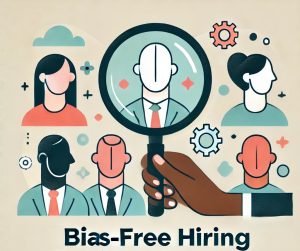In recruitment, DEI goes beyond simply filling quotas. It’s about actively building teams that reflect the rich tapestry of our world – diverse in background, perspective, and experience. But why is DEI recruitment so crucial now? The answer is multifaceted and deeply rooted in business success. Diverse and inclusive teams are demonstrably more innovative. Different backgrounds bring varied perspectives, leading to creative problem-solving and fresh ideas. Decision-making improves as groupthink diminishes, replaced by robust discussions and a wider range of viewpoints. DEI recruitment expands your talent pool, allowing you to tap into previously overlooked reservoirs of skill and potential, bolstering your employer brand and attracting top candidates who value inclusive environments. Finally, in an increasingly globalized marketplace, a diverse workforce helps you better understand and serve your diverse customer base.
Inspiring example: Unilever, a global consumer goods giant, exemplifies a company deeply committed to DEI. They actively showcase diverse representation in their advertising campaigns and have set ambitious targets for gender balance and ethnic diversity within their leadership teams. Their commitment stems from a core belief that diverse teams drive better business outcomes and innovation, reflecting their diverse global consumer base.
Building a diverse talent pipeline: sourcing beyond the usual suspects
Building a truly diverse workforce starts long before the interview stage – it begins with your talent pipeline. If you keep fishing in the same pond, you’ll keep catching the same kinds of fish. To build a diverse talent pipeline, you need to actively seek out candidates from underrepresented groups and expand your sourcing horizons.
- DO: Invest time in building genuine, long-term relationships with diversity-focused organizations. Don’t just show up when you need to fill a role. Offer sponsorships, mentorship opportunities, or participate in their events year-round. Track your sourcing channel effectiveness to understand which efforts are yielding the best results.
- DON’T: Rely solely on general job boards and expect a diverse pipeline to magically appear. Treat diversity sourcing as a box-ticking exercise or a last-minute scramble. This will come across as inauthentic and won’t attract genuine talent.
Inspiring example: Google has invested heavily in building a diverse tech pipeline through various initiatives. They offer coding programs and scholarships targeted at underrepresented minority students, partner with Historically Black Colleges and Universities (HBCUs) and Hispanic-Serving Institutions (HSIs), and run outreach programs to encourage girls and young women to pursue STEM careers. These long-term investments demonstrate a genuine commitment to building a more inclusive future for the tech industry.
Inclusive hiring practices: levelling the playing field for all candidates
Once you have a diverse applicant pool, the next critical step is to ensure your hiring process itself is inclusive and equitable. Inclusive hiring practices aim to remove bias from the process and ensure all candidates are evaluated fairly based on their skills and potential.
- DO: Invest in unconscious bias training for all hiring managers and recruiters. Regularly audit your job descriptions, application process, and interview materials for inclusivity. Seek feedback from diverse employees on your hiring processes.
- DON’T: Rely on “gut feeling” or subjective impressions during candidate evaluations. Use “culture fit” as a primary hiring criterion – this is often a proxy for affinity bias and can perpetuate homogeneity. Assume your current hiring process is inherently fair; proactively look for areas to improve inclusivity.
Key inclusive practices:
- Anonymized applications: remove names, gender indicators, and other potentially biasing information from initial application screening. This forces the focus solely on skills, experience, and qualifications.
- Standardized interview processes: implement structured interviews with pre-defined, consistent questions asked to all candidates for a specific role. Use standardized scoring rubrics to evaluate responses objectively against pre-determined criteria.
- Diverse hiring panels: ensure interview panels are diverse in terms of gender, race, background, perspectives, and even functional expertise. Diverse panels reduce groupthink, mitigate individual biases, and provide candidates with a more welcoming and representative experience.
- Accessible application process: ensure your online application system is accessible to people with disabilities, adhering to WCAG guidelines. Offer accommodations for interviews (e.g., sign language interpreters, materials in alternative formats). Be proactive in asking candidates about any accessibility needs.
- Inclusive language in job descriptions: scrutinize job descriptions for unintentional bias. Avoid gendered language, jargon, and culturally specific terms. Focus on skills, competencies, and required experience rather than vague notions of “culture fit.”
Inspiring example: Accenture is recognized for its skills-based hiring approach, emphasizing objective assessment of skills and potential over subjective factors. They have implemented blind resume screening and structured interviews across their global operations to reduce bias and create a more equitable recruitment process. IBM is another leader, renowned for its commitment to accessibility, not only in their workplaces but also in their hiring process, ensuring candidates with disabilities have a fair and inclusive experience.
Asking inclusive interview questions: focusing on skills and potential
The questions you ask in an interview are powerful signals of what you value and what you are looking for. Inclusive interview questions are designed to uncover a candidate’s skills, experience, and potential in a way that is fair, unbiased, and respectful of diverse backgrounds. They shift the focus from potentially biased or irrelevant personal details to core competencies and job-related behaviors.
- DO: Meticulously prepare structured, behaviour-based and situational questions for each role. Train interviewers to ask these consistent questions and probe for specific, detailed examples using the STAR method. Focus your questions squarely on job-related skills, experience, and future potential.
- DON’T: Ask off-the-cuff questions that can be inconsistent and biased or leading questions that reinforce stereotypes or make assumptions about candidates based on their background. Use interview questions as a casual “get to know you” session or to assess “fit” based on shared personal traits – keep it professional and focused on competencies.
Inspiring example: companies like L’Oréal are known for their robust interviewer training programs that specifically address inclusive interviewing techniques. They train interviewers to recognize and mitigate unconscious bias, and emphasize the importance of asking standardized, behavior-based questions that focus on skills and experience, rather than subjective impressions.
Measuring and sustaining DEI in recruitment: accountability and continuous improvement
Building a diverse and inclusive workplace is not a one-time fix – it’s an ongoing journey. Measuring your progress and holding yourself accountable are crucial for sustaining your DEI efforts in recruitment and beyond.
- DO: Establish clear baseline metrics and set realistic, yet ambitious, targets for improvement. Use data to inform your DEI strategy and rigorously track your progress against those targets. Be transparent about your data and progress (internally, and externally where appropriate) to foster accountability.
- DON’T: Just collect data without analysing it or using it to drive meaningful change. Focus solely on high-level representation numbers without investigating underlying systemic issues or disparities in the hiring process.
Key metrics to track:
- Diversity demographics of applicant pools, interview shortlists, and hires: track representation across gender, race/ethnicity, and other relevant diversity dimensions at each stage of the hiring funnel.
- Candidate feedback on inclusive hiring practices: gather data on candidate perception of fairness and inclusivity through post-application and post-interview surveys.
- Time-to-hire and offer acceptance rates across different groups: identify any disparities that might indicate bias in the process.
- Employee retention rates for diverse groups: recruitment is only the first step; monitor retention to ensure your workplace is truly inclusive and supportive for all employees.
Regularly review and report on DEI data:
share your progress (and areas for improvement) internally to demonstrate transparency and commitment. External reporting (in aggregate, anonymized form) can also enhance your employer brand and attract DEI-conscious candidates.
Establish accountability for DEI goals:
integrate DEI metrics and goals into performance reviews for recruiters and hiring managers. Make DEI a shared organizational objective, not just an HR initiative.
Treat DEI as a continuous improvement process:
regularly review your DEI strategy, analyze your data, adapt to new best practices, and proactively seek feedback from employees and candidates. DEI is not static; it requires ongoing learning and evolution.
Inspiring Example: Companies like Intel and Microsoft are increasingly transparent about their DEI data, publishing annual diversity reports that detail their workforce demographics, hiring statistics, and progress towards DEI goals. They use this data to track their performance, identify areas where they need to improve, and publicly hold themselves accountable for making progress.
Recruitment as the cornerstone of a truly diverse and inclusive workplace
Diversity, equity, and inclusion in recruitment is far more than a checklist of best practices. It is the cornerstone of building a truly diverse and inclusive workplace culture – a culture where everyone feels valued, respected, and empowered to contribute their best work. By intentionally designing inclusive recruitment processes, expanding your talent pipelines, and continuously measuring and improving your efforts, you are not just ticking boxes; you are building a stronger, more innovative, and equitable organization for the future. Recruitment is the crucial first step in creating a workplace where diversity thrives and inclusion is not just a program, but a lived reality. Embrace DEI in recruitment not just as a strategy, but as a core value – and you will unlock the immense potential of a truly diverse and empowered workforce.






